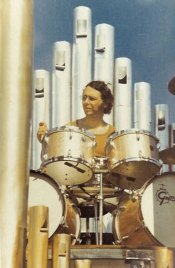


Goliath's Pit Tavern & Dance Hall - 3/13 Wurlitzer
GOLIATH AND HIS COLORFUL MASTER
Carnation, Washington
Organ installation timeframe: 1962 - early 1990's
Back to the Restaurants, Taverns and Social Clubs page
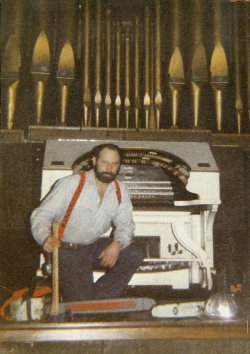
Kirk Whitcombe with "Goliath"
The Goliath's Pit organ was based around a three-manual Wurlitzer from the Elsinore Theatre in Salem, Oregon. Kirk Whitcombe acquired the organ in 1969.
The "Pit" was a tavern and dance hall setup by Kirk in a former I.O.O.F. hall. An interesting feature of the organ was the 32' plywood Diaphones built by Kirk.
Before "The Pit," Kirk installed the organ in several locations including a barn near Lake Sammamish and in a portable configuration using several tractor trailers that could be hauled to fairs and other Summer events around the Northwest.
The Pit building and organ were eventually sold. In the early 1990's, the organ was sold to Terry Robson of Portland and disbursed for parts. The console went to Dick Loderhose of Seal Beach, California.
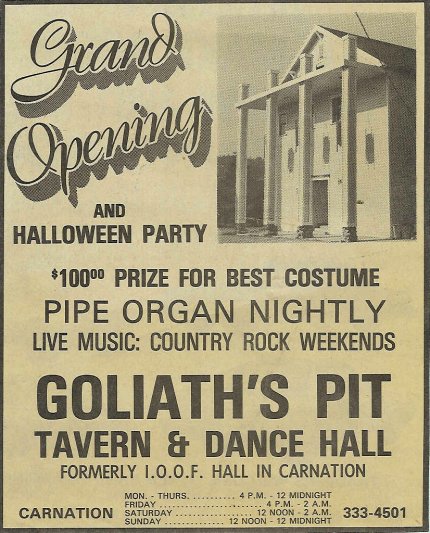
From the Snoqualmie North Bend Valley Record
The following was contributed by Clyde Shoe (April, 2003):
by
Clyde Shoe
He was big: 34 feet tall and 60 feet long, weighing 32 tons. He was a Wurlitzer theater pipe organ, named Goliath after the biblical giant. Goliath called the Sno-Valley Senior Center home long before the seniors did. A logger named Kirk Whitcombe owned this mammoth musical instrument. You will get to know Kirk better—maybe like him, maybe not, I don’t know. But you won’t be neutral.
Genesis. Goliath’s three keyboard console controlled 1,644 pipes, ranging in size from a pencil to a howitzer. Theater pipe organs were invented to accompany silent motion pictures. They reproduced sounds of doorbells, fire gongs, gun shots, breaking glass, tom-toms, clarinets, trombones, tubas, castanets—and just about every other sound. The musician could orchestrate all kinds of changing movie scenes: marching bands, romantic interludes, funeral dirges. Goliath could do all that, because Goliath was invented to do all that. Goliath’s console even operated a grand piano up on the second floor, up where the museum now is. The thing about organs is that all their parts don’t have to be together. The console could be in one room, the blowers, wind chests, pipes, and everything else in another room or even another building.
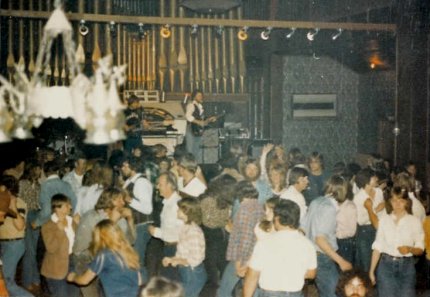
Dancers at Goliath's Pit. Town fears of rowdiness proved unfounded.
Goliath’s first home was in the Elsinore Theater in Salem, Oregon, in 1926, where he started life knocking the socks off patrons of silent movies. Kirk bought Goliath in 1962. Kirk was an independent logger, a gyppo. The first question a lot of people ask is, how did a logger get started with a huge pipe organ? That question is answered when you know that Kirk once played keyboard with The Embalmers, a rock band complete with a stage-prop coffin. Kirk graduated from keyboard to a small organ and then, Kirk being Kirk, to the largest theater organ he could find. He spent years converting Goliath to (here we go again) the largest portable pipe organ in the world, then hauling it on his logging trucks to various public events in the Puget Sound area.
In 1974 he bought the old, two-story Odd Fellows hall, now the senior center, for Goliath’s home. The 34-foot pipe organ was almost as tall as the building, so Kirk cut a huge hole out of the second floor, and ringed it with a wooden-railed gallery to make it cozy for Goliath. That huge hole was called Goliath’s Pit. I still call it that.
The seniors have been griping about all the lost floor space ever since they bought the building in 1992. Huntley Berg reports that they actually once got a grant to floor in the Pit, chickened out because of structural concerns, and gave the money back. I’m glad. The Pit makes the dining room, with its railed gallery and soaring ceiling, into a grand ballroom. How many senior centers can boast of that?
Do Unto Others. Even though our dining room is grand, it is full of warmth and friendship. Take Paige Denison’s exercise class. The exercisers get as much camaraderie as they do muscle tone. Does Paige ignore the toothpaste smeared on my chin? No, she wipes my chin, and compliments me for brushing my teeth, just as she doubtless does her young sons and husband. I ask you, where else could you get such warm fuzzes in a workout?
Then there is Kate Miller, our program coordinator, who, in Kate’s version of a sotto voice, says, “Clyde, your fly is open.” It takes a real friend to say that. Many would just avert their eyes and let me walk off unbeknownst. I am expected, however, to zip up on my own. Must be a senior services rule.
Diaphones. Kirk made many improvements in Goliath, but the most dramatic was when he built a set of 32-foot diaphones—a size very rare and powerful. These were made of wood, four feet square and 32 feet long, furnishing a full, round, rich resonating tone. Fog horns are another type of diaphone, so you know what ball park we are playing in. Kirk’s diaphones were powered by a ten horsepower blower that was in addition to the pipe organ blower. You wouldn’t believe how much air a blower that size can blow. Kirk succeeded in doing something that, for most of humanity, remains only a dream: Making music from a fog horn. His resonating BOO—UNKS were awesome. Resonations could have reached the city limits, and for sure could have shivered the timbers of city hall next door, but Kirk exercised uncommon restraint, never pulling out all the stops. You will see later that “restraint” was not a Kirk characteristic.
The music selection the dancers most favored was Space Odyssey. Then, with the 32 foot diaphones rocking the building, Kirk would drift into Whole Lotta Shaking Going On. Oh, man! If you feel a gentle shaking in the building, it may not be an earthquake. It may be Goliath’s ghost.
Rub-a-dub-dub. For a time Kirk and his family lived upstairs. His quarters sported a magnetic attraction: an aerial bathtub. This full-sized, claw-footed tub was ten feet off the floor, suspended by chains from the ceiling. You are going to ask why. It was for the very good reason that there wasn’t room for it on the floor where, admittedly, most bathtubs are found. The tub rested on a platform so the bather wouldn’t get seasick swinging on the chains. Steps led from the floor to the platform for shinnying up and down. Get the picture? I know it’s hard.
There must have been a steady stream of rubberneckers to view the tub, because it was well known, even famous, around town. This aerial bath was located smack-dab where the desk of our director, Lisa Yeager, now stands. Eat your heart out, Lisa. You missed your chance to soak while doing the budget.
It always puzzled Kirk why his bathtub attracted more curiosity than his pipe organ. What did that say about the decent, honest people of Carnation? Yes, I know, Cleanliness is next to Godliness, but the townies didn’t actually bathe in Kirk’s tub. They just gawked, rolled their eyes, clucked their tongues, but seldom swung by to marvel Goliath.
Home but not Sweet Home. Conflict between Kirk and the town started soon after he moved to Carnation. Kirk thinks it was because the town was leery of the idea of hundreds of people whooping it up and dancing to the music of the biggest instrument most locals had ever seen or heard tell of.
The Columns. Kirk became four thorns in the town’s side when he erected four, two-story logs on the south side, nicely finished to match the building exterior. These columns replaced flimsy ones holding up the portico, and made the entrance look like the entrance to an antebellum plantation mansion. The columns were on the sidewalk—town property—just as the replaced supports had been. Eventually city hall added a $300,000 insurance requirement as a condition for issuing a permanent business license. Kirk indignantly claimed inconsistent treatment, and sparks began to fly.

Kirk got some support in 1983 from Councilman Ted Gombiski, who pointed out that others had been permitted to put up uninsured structures on city rights-of-way. “We are talking about something in place nine years. There was no objection when they were built. No objection when they were remodeled five years ago.” Gombiski’s motion to issue a business license was voted down, but the columns stayed in place without insurance until the building was sold. The seniors finally pulled them down in 1992, when the main entrance was moved to its present location.
But score: Kirk 4, town, 0.
The Sewer. Kirk sued the town over what he thought were excessive sewer requirements. Wes Larson, a councilman in the 1980s, told me Kirk always had big ideas and would never give an inch. Wes said that if Kirk had been willing to cut his occupancy projections a little “we might have been able to accommodate him on the sewer permit, but he wouldn’t and we didn’t.”
One time Kirk became so incensed in a council meeting over the sewer matter that he smashed his fist into the chamber wall and broke it—his hand, that is. I got the same broken hand story from both Wes Larson and Kirk Whitcombe. It was possibly the only thing they ever agreed on.
Crap score: Kirk, one broken hand, no permit. Town, sewer standards triumphant.
Judy Peterson, Kirk’s bookkeeper, said that to Kirk the principle of any issue was everything, costs and consequences not much. She said he definitely marched to the beat of a different drummer. She tried to guide Kirk on financial matters, but that must have been like trying to herd a Billy goat.
The Flag. Kirk would take on anybody. He sued Weyerhaeuser over a contract dispute concerning salvage timber on Mt. St. Helens. During the suit Kirk claimed that the judge denied him his constitutional rights when he refused Kirk a jury trial. In protest he painted a 28-by 35-foot up-side down American flag on the east side of his building. An up-side down flag is a distress signal, and Kirk was in distress. Picture how big 28-by 35 feet is. My house would fit on it. Kirk always did things in a big, big way, even distress.

Goliath's Pit building, 1987
The flag upset a lot of people in town. The Seattle Times carried this quote in a March 20, 1987 article: “A lot of people think this is disrespectful,” said one man who asked not to be identified. “But as many stumbling blocks as the city has put in his way, I can understand. I guess he really feels he is in distress.”
Kirk wasn’t done. He then painted this proclamation on the city hall side of the building: “Condemned by City of Carnation.” Distress takes a lot of paint.
The End. Kirk lost the Weyerhaeuser case and was forced into bankruptcy. He still misses his many Carnation friends and the good times he had, but he hates lawyers. You are not the only one to feel that way, Kirk: “The first thing we do,” said a character in Shakespeare’s Henry VI, “is kill all the lawyers.”
Tonasket, Washington, where Kirk and his family now live, welcomes him, but he doesn’t have his pipe organ, and his logging business doesn’t butt up (excuse me, I meant “but up”) against council member concerns. Kirk now plays the saxophone. You might say that Tonasket hasn’t been thoroughly tested...yet.
Like the biblical David and Goliath, where David slew Goliath with his sling, then cut off Goliath’s head, the seniors sold Goliath to a chop shop. The console went to California, and the rest dispersed for parts. Does that make you sad? It does me.
When I walk into the dining room, I see Goliath’s old spot marked by a flag hanging on the back gallery. In my mind’s eye this room is glazed with Goliath’s memory, and no amount of passing events will erase his towering presence. To those several people who told me that Kirk Whitcombe was bad for the town, I say, with gratitude and sincerity: Oh, shut up. He is part of your town’s colorful heritage.
From the Snoqualmie North Bend Valley Record, Thursday June 30, 1977:
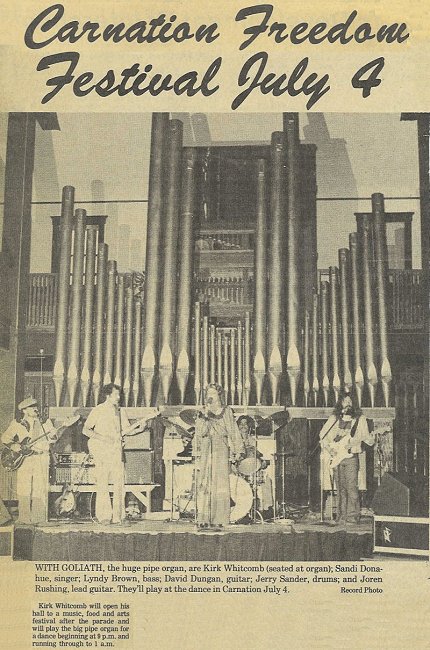
![]() Editor's note: Prior to installing the 3/13 Wurlitzer at "The Pit," Kirk had a 2/5 Kimball theatre pipe organ configured as a traveling instrument. Fate of this instrument is unknown.
Editor's note: Prior to installing the 3/13 Wurlitzer at "The Pit," Kirk had a 2/5 Kimball theatre pipe organ configured as a traveling instrument. Fate of this instrument is unknown.
From the The Console magazine, July 1970:
SEATTLE YOUNGSTER MODIFIES THEATRE PIPE ORGAN FOR PORTABLE TOUR UNIT
For a spectacular organ scene, the portable theatre pipe organ fabricated by Kirk Whitcombe of Seattle, Washington for his musical group will overshadow almost any kind of production wherever it is set up. It is also of great interest to organ enthusiasts the world over to learn that the younger generation is stepping into the theatre organ picture and undoubtedly will make good use of the instrument.
Young Whitcombe’s adventure is one that displays his imagination and inventiveness. He modified the present organ he owns without previous knowledge of other pipe organs that were portable units— the famous five—manual Moller owned by Reginald Foort in England, and the one used for a brief time in the United States by the late C. Sharpe Minor were used for concert tours.
By the time information was obtained from Kirk about his Kimball-Morton-Wurlitzer instrument, he was in the midst of a great problem. Early in July he and his group will open at the Seattle Coliseum for an engagement. He has this month purchased the Wurlitzer formerly owned by David C. Guthrie, who has moved to Canada and decided not to move the organ to his new residence. Kirk may attempt to modify the Wurlitzer in time for the Coliseum presentation, but if this is not feasible, he plans to have it ready for his next engagement which may be in California.
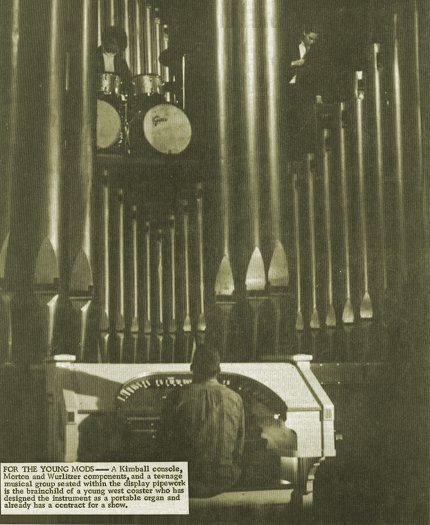
The Kimball is transported in two forty—foot vans and can be set up, tuned and played within six hours from the time it is unloaded; it is a five—rank organ. Complete information about the portable instrument - when Kirk first thought of using a pipe organ how he built
it, when he formed his musical group— will be published a forthcoming issue of The Console. In this issue of the paper, the Kimball—Morton—Wurlitzer, and other pipe organ components owned by the young builder—artist—showman are listed for sale in the Organ—ized Ads Section.
It is interesting to note that he has plans for adding a set of 32’ diaphones to the Wurlitzer. “Kids today want power with their music— and what is better power than a big, visible set of 32’ diaphones!” he exclaimed.
About this site © PSTOS, 1998-2005
